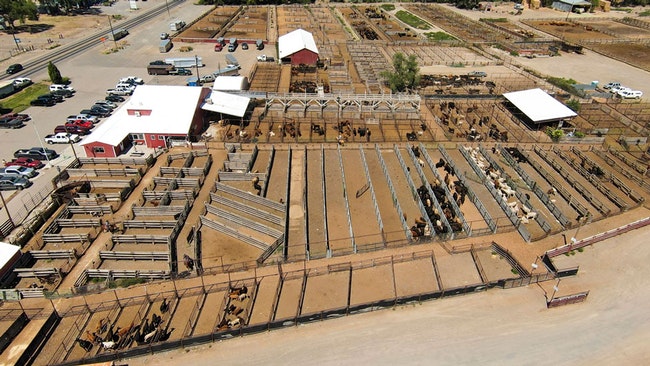
Ranchers and farmers are bracing for an upcoming growing and harvest season haunted by the specter of drought. (The Enterprise/FILE)
VALE – Malheur County is forecasting “widespread and severe economic damage” because of the area’s drought conditions, according to a county declaration of emergency.
The Malheur County Court approved the declaration on Wednesday, April 6, and asked Gov. Kate Brown to declare a state emergency as well to open the doors for state aid.
At stake is millions in sales from agriculture and livestock production and a series of climatic conditions that could dry out the high desert steppes of southeastern Oregon and create ideal conditions for range fires.
The county now is in severe to extreme drought conditions, according to the National Oceanic Atmospheric Administration’s drought information system.
The governor has already declared a drought emergency in 10 other counties. Malheur County could get state resources to deal with the water shortage.
The county declaration was sought by Lt. Rich Harriman, the county’s emergency services director.
The county wants the state to instruct the Oregon Water Resources Department to approve temporary transfers of water rights, emergency water use permits and the use of existing water rights options available locally.
A drought permit allows a user to replace water temporarily outside the existing water right. The most common drought permit allows an individual to use groundwater as a substitute for an existing water right.
A temporary transfer of water rights allows a user to modify the type of use, place or the area of a water diversion under the existing water right.
The county pointed to lack of snow and rainfall along with below average fuel moisture levels in vegetation as key reasons for the declaration.
A snow water equivalent of only 19% of normal for the Malheur Basin played a role in the drought declaration.
“In severe drought conditions, you can expect pastures are brown; hay yields are down and prices are up; producers are selling cattle. Fire risk increase. Marshes are drying up, little water is available for livestock and wildlife,” the declaration said.
The declaration also described the impact on the county’s ranching industry.
“Ranchers will have to truck water into their livestock,” the declaration said. “Livestock have to walk greater distances to get water and this contributes to exaggerated numbers of ‘dust pneumonia’ cases in calves.”
The court also declared a drought emergency in 2021.
The drought, coupled with low reservoir levels, will hit the local cattle industry hard, according to Chris Christensen, a Malheur County rancher who is a vice president of the Oregon Cattlemen’s Association.
“It is already affecting feed prices. They’ve doubled and tripled in some places and hay prices are going through the roof,” said Christensen.
Pasture grass could also be in short supply.
“Depends where you are at but it will be a short grass year,” said Christensen.
The drought also affects alfalfa, which is typically a thirsty crop.
“Normally these guys out there cut three or four cuttings of hay. This year they are talking about getting maybe one. It’s really negative,” said Christensen.
The below-average fuel moisture levels in vegetation and sagebrush across the county improved recently, said Al Crouch, fire mitigation/education specialist for the Vale District of the Bureau of Land Management.
“With the recent rain we did have our last report come in about average,” said Crouch.
Crouch said, however, the spring months across the county are predicted to be dry.
He cautioned it is still early to make conclusions about how dry the county will be.
“The better time to tell is really around Memorial Day,” said Crouch.
The central Malheur County area is a bread basket carved out the high desert because of the availability of water. With reservoirs showing low levels and drought lingering, huge cash crops such as onions will suffer, said Stuart Reitz, Malheur County extension agent.
“It is really a question of how long the water lasts and is it going to be enough?” said Reitz.
Recently, the Owyhee Irrigation District set a new allotment for irrigation water users at 2.1-acre feet. Last year the Owyhee Irrigation District cut its water allocation from 4-acre feet to 3-acre feet. An acre foot of water is enough water to flood an acre 1 foot deep. About 35,000 acres of farmland rely on the Owyhee Reservoir. Around 170,000 acres in Malheur County rely on irrigation water.
Reitz said the drought forced farmers to prioritize what they plant.
“They are going to try to get the water to onions just because they are a high value crop, so people cut back on other things. People have cut back on corn that they were thinking of, so they put in some really lucrative crops like spring wheat. It doesn’t take a lot of water relative to other things,” said Reitz.
New tip? Contact reporter Pat Caldwell at [email protected]
Previous coverage:
Severe drought hitting Malheur County
Blistering heat blasts Malheur County crops, could impact yield
EXCELLENCE IN JOURNALISM – Available for $5 a month. Subscribe to the digital service of the Enterprise and get the very best in local journalism. We report with care, attention to accuracy, and an unwavering devotion to fairness. Get the kind of news you’ve been looking for – day in and day out from the Enterprise.




